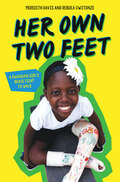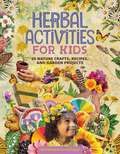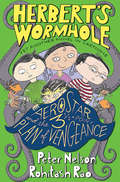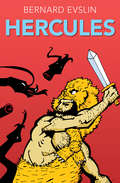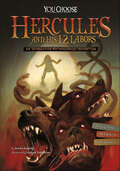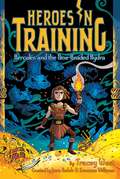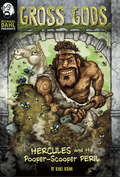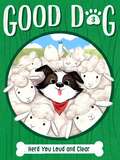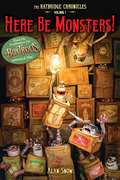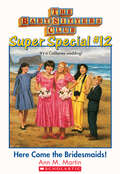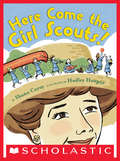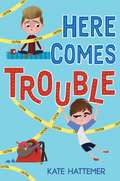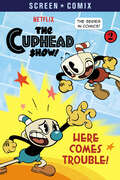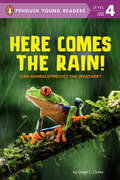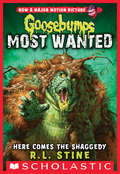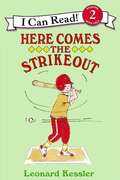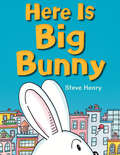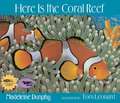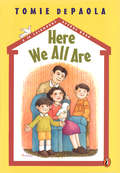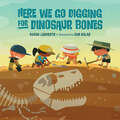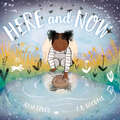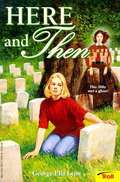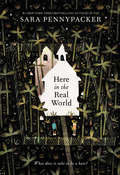- Table View
- List View
Her Own Two Feet (Scholastic Focus): A Rwandan Girl's Brave Fight To Walk
by Meredith Davis Rebeka UwitonzeThrough her eyes, the moving story of a young Rwandan girl born with clubfeet and the risk she takes for the chance to walk on the bottoms of her feet for the first time.Rebeka Uwitonze was born in Rwanda with curled and twisted feet, which meant she had to crawl or be carried to get around. At nine years old, she gets an offer that could change her life. A doctor in the US might be able to turn her feet. But it means leaving her own family behind and going to America on her own.Her Own Two Feet tells Rebeka's inspiring story through her eyes, with the help of one of her hosts. She travels from Rwanda to Austin, Texas, to join the Davis family, despite knowing almost no English. In the face of dozens of hospital visits and painful surgeries, Rebeka's incredible bravery and joyful spirit carry her to the opportunity of a lifetime. A stunning debut about hope, perseverance, and what becomes possible when you take a risk.
Herbal Activities for Kids: 50 Nature Crafts, Recipes, and Garden Projects
by Molly Meehan BrownA rich, colorful compendium of crafts, cooking, gardening, and nature exploration activities introduces kids ages 7 and up to the versatility and creative fun of working and playing with herbs. From dandelions to lavender, chamomile, turmeric, and lemon balm, herbs include a wonderfully diverse range of plants for crafting, cooking, and gardening. Kids will love exploring the world of herbs with this lively and colorful collection of 50 nature-based activities created by Molly Meehan Brown and the global community of herbalists who contribute to the Wild Ginger Community Herbal Center. Filled with photos and the whimsical art of Madison Safer, this eclectic and colorful compilation volume features easy-to-follow projects that engage all five senses. Includes activities for different ages and interests such as: How to make a pressed flower and herb collage Tie-dye fabric with turmeric Make elderberry syrup Plant a pollinator garden Make wild berry crumble Craft an herbal wreath or a flower bracelet Write a nature haiku Make lemon balm lip balm, and more! With bits of lore about herbs and herbalism sprinkled throughout, this is the perfect introduction to the versatility and usefulness of herbs for kids ages 7 and up.
Herbert's Wormhole: AeroStar and the 3 1/2-Point Plan of Vengeance
by Peter Nelson Rohitash RaoThis is the greatest adventure yet for the worlds most famous 11-year-old time-traveling alien slayers A mysterious foe name AeroStar has destroyed the future and is in danger of coming through the wormhole to the present Shes a power-hungry, mega-evil, super nasty villainess bent on revenge against he three meddling kids who disrupted her diabolical plans to control Future Merwinsville: Alex, Herbert, and me, Sammi The weirdest thing is no one knows how this horrible old lady is or where she came from Do we, guys? . . . Guys?This will not end well. Thats all I can say.
Hercules
by Bernard EvslinGreek mythology&’s mightiest hero faces the world&’s most fearsome beasts, monsters, and demons Hercules, the son of Zeus and a mortal woman, was the greatest of the Greek heroes and the strongest man on earth. Three times as big as his fully mortal twin, and imbued with extraordinary courage and ingenuity, Hercules began his remarkable feats while still in the cradle. Zeus&’s wife, the goddess Hera, jealously schemed to kill Hercules, but the resourceful half-man, half-god escaped her traps and accomplished seemingly impossible tasks. Renowned mythologist Bernard Evslin recounts the famous twelve labors of Hercules, as the warrior tries to break Hera&’s curse by facing down the Nemean Lion, killing the many-headed Hydra, outwitting the giant Anteus, and more.
Hercules and His 12 Labors: An Interactive Mythological Adventure (You Choose)
by Anika FajardoYou are the mighty Greek hero Hercules. As a half-god, you are stronger than mere humans. You've faced many challenges. But now you face your most difficult test yet. The goddess Hera has given you a task worthy of a god—complete the dangerous 12 labors and live forever. Can you survive and win your immortality? Full-page illustrations, interactive stories, and multiple endings transport you back to ancient Greece and into Hercules' adventures from Greek mythology.
Hercules and the Nine-Headed Hydra (Heroes in Training #16)
by Tracey WestZeus and his friends are back for another adventure in this latest Heroes in Training chapter book!Since defeating the Titans, Zeus and his fellow Olympians have taken over Mount Olympus. Things are nearly back to normal…until a stranger named Hercules shows up, asking for help. He&’s on the run from Eurythseus, King of Argon, who is after Hercules for egging his temple. Before Zeus can help, Eurythseus himself appears. It turns out that Hercules has also been bragging that he is the ruler of Olympus, and Eurythseus intends to declare war on the Olympians&’ new home. Zeus&’s friends come up with an idea—maybe Hercules could make up for egging Eurythseus&’s temple. The Oracle Pythia reveals that in order to do this, Hercules must get a scale from a huge, nine-headed serpent—the Hydra. Will this be enough to please Eurythseus? Or is another battle on the horizon for the Olympians?
Hercules and the Pooper-Scooper Peril (Michael Dahl Presents: Gross Gods Ser.)
by Blake HoenaThe mighty Hercules takes on twelve disgusting feats -- including scooping massive mountains of manure -- in this epically gross Greek myth retelling! Will the demigod rise to the awful occasion, or will he totally poop out? With wacky illustrations, true-to-tale back matter, and introductions by award-winning author Michael Dahl himself, THE GROSS GREEK GODS series will have mythology lovers and gross-out fans alike reading in legendary proportions.
Herd You Loud and Clear (Good Dog #3)
by Cam HigginsIn the adorable third book of the Good Dog series, Bo learns to herd the sheep on the farm—the hard way!Loveable puppy Bo Davis has his work cut out for him when he has to herd the farm&’s sheep by himself! With easy-to-read language and illustrations on almost every page, the Good Dog chapter books are perfect for beginning readers.
Here Be Monsters! (The Ratbridge Chronicles #1)
by Alan SnowEntertaining antics and skullduggery abound in the book that inspired Laika Studio’s animated film The Boxtrolls, in theaters September 26, 2014!Welcome to Ratbridge. But beware—for there is skulduggery afoot. Young Arthur has fallen foul of the appalling outlaw, Snatcher, and is trapped alone in the town with every way home sealed. Meanwhile Snatcher and his men are working tirelessly in secret on a fiendish and dastardly plan to destroy the entire town. With the help of some friendly boxtrolls and cabbageheads, some quirkly townspeople, and the rats and pirates from the Ratbridge Nautical Laundry, can Arthur thwart Snatcher’s evil plans and find his way home?
Here Come The Holidays!: Stories And Poems
by Stephanie Calmenson Debbie Dadey Suzy Kline Barbara Seuling David Wenzel Sue WrightThis book has as many surprises as there are presents under a Christmas tree including a zombie, a lost dog, Christmas slime, a brave, generous camel, a soldier and the family who miss him, Christmas carols, mice caught snitching tinsel from the Christmas tree, and lots of candles and fun. These are short holiday stories and poems to read again and again
Here Come the Bridesmaids!: Here Come the Bridesmaids! (The Baby-Sitters Club Super Special #12)
by Ann M. MartinThe Baby-Sitters are invited to weddings on both coasts in this entry from the classic, hit series.When two weddings give three club members the opportunity to be bridesmaids, Claudia and Dawn excitedly fly out to California to participate in Dawn’s father’s nuptials, while an enthusiastic Stacey attends Mrs. Barrett in Stoneybrook. The best friends you’ll ever have—with classic BSC covers!
Here Come the Girl Scouts!: The Amazing All-true Story of Juliette "Daisy" Gordon Low and Her Great Adventure
by Shana CoreyThe amazing, all-true story of the first Girl Scouts and their visionary founder.Juliette Gordon Low--Daisy to her friends and family--was not like most girls of the Victorian era. Prim and proper? BOSH! Dainty and delicate? HOW BORING! She loved the outdoors, and she yearned for adventure! Born into a family of pathfinders and pioneers, she too wanted to make a difference in the world--and nothing would stop her. Combining her ancestors' passion for service with her own adventurous spirit and her belief that girls could do anything, she founded the Girl Scouts. One hundred years later, they continue to have adventures, do good deeds, and make a difference!
Here Comes Ginger (The Ginger Series #2)
by Elaine L. SchulteGod, if You’re really there... Stop Mom’s wedding! Ginger's world is falling apart. Her mom has recently become a Christian and, even worse, has fallen in love with Grant Gabriel. Ginger can't stand the thought of leaving their little house near the beach... moving in with Grant and his two children... trading in her “brown cave of a bedroom” for a yellow canopied bed. Ginger will try anything to fight the changes she knows are coming--green fingernails, salt in the sugar bowl, a near disaster at the beach. But she finds that change can happen inside her, too, when she meets the Lord her mom has come to trust.
Here Comes Trouble
by Kate HattemerThe hilarious story of a wannabe-reformed-prankster perfect for readers who loved Dead End in Norvelt and Better Nate Than Never.Soren Skaar is a notorious prankster. After his partner-in-pranking-crime moves away, Soren's ready to leave his life of causing trouble behind. But when his hipster Brooklynite cousin comes to "study abroad" with his family in small-town Minnesota, Soren's plans for reform fall by the wayside. Soon all Soren can see are opportunities to prank, and his shenanigans have done nothing to win over his cousin. It isn't long before he's in over his head, and Soren can't help but wonder who he'll be if he loses this part of himself. Can he give up his life as a jokester, or is the joke on him?"Give this to fans of the "Wimpy Kid" series who are looking for longer novels."--SLJ"A fast, engaging read."--Booklist
Here Comes Trouble! (Screen Comix)
by Random HouseTwo episodes of The Cuphead Show! retold in graphic novel-style deluxe paperback with full-color images and dialogue from the animated Netflix series, featuring Cuphead and Mugman!The Cuphead Show! follows the adventures of two lovable brothers—Cuphead and Mugman—through their unique misadventures! Whether it&’s angry mermaids, boxing frogs, or strange carnivals filled with danger, the brothers often find themselves in hot water. But whoever—and whatever—they encounter on their home of Inkwell Isle, they&’ve always got one another&’s backs. Fans of the animated Netflix series and the video game that inspired it will love the second 80-page graphic novel-style Screen Comix with full-color images and dialogue from the laugh-out-loud series!
Here Comes the Rain!: Can Animals Predict the Weather? (Penguin Young Readers, Level 4)
by Ginjer L. ClarkeLearn about whether or not animals around the world can sense the weather (spoiler alert - some can!) in this photographic nonfiction leveled reader perfect for kids interested in real-life animals that can do unbelievable things!Did you know that sharks have such sensitive hearing that they can tell when hurricanes are coming? Or that you can tell when it's about to rain when sheep start huddling together after they sense a storm on the wind? These animals are real-life weather predictors! With simple language and vivid photographs, Here Comes the Rain!: Can Animals Predict the Weather? is perfect for emerging readers curious about the natural world and the fascinating abilities of the animals that live within it.
Here Comes the Shaggedy (Goosebumps Most Wanted #9)
by R. L. StineThe infamous, Most Wanted Goosebumps characters are out on the loose and after you. Kelli and Shawn Anderson are not excited about having to move to another state - especially because their new home is directly next to a giant swamp. But their dad is a scientist and he's going down there to study the local flora and fauna. Unfortunately for Kelli and Shawn, there seem to be some very strange creatures that live around their house. They keep hearing about the legend of the Shaggedy, an ancient beast that lives far below the surface of the swamp and can cause a whole lot of damage. Can Kelli and Shawn convince their dad to move back home before it is too late?
Here Comes the Strikeout! (I Can Read! #Level 2)
by Leonard KesslerHitting the ball is hard work, but after lots of practice and advice from his friend Willy, Bobby learns how.
Here Is Big Bunny
by Steve HenryWhose giant foot is that? Where are those ears going . . . ? Through windows, behind trees, and behind buildings, Big Bunny is peeking out. More than one hundred fifty colorful animal characters, busily walking through their city, stop and look at the giant bunny in their midst. What could all of these clues add up to? Why, it's Big Bunny—a huge balloon, sailing down the street with a smile in the middle of a parade! Beginning readers will love searching through Steve Henry's detailed spreads for hints, looking for Big Bunny in each spread. The text features brief, simple sentences with no more than one word changing from page to page, making this one of the first books a child will be able to read on their own. For older readers, an author's note explains the inspiration behind the story, artistic influences, and some of the unexpected treasures hiding on the page. Bold colors and creative cutaways make this a fun read, and there's always some new detail to discover!
Here Is The Coral Reef
by Madeleine Dunphy Tom LeonardSet in Australia's Great Barrier Reef, this lyrical rhyming tale introduces young readers to some of the coral reef's most striking residents. From the sleek shark to the colorful parrotfish to the deceptively beautiful sea anemone, each creature in this abundant undersea world relies on another for its existence. Beginning with coral, the very element that defines this ecosystem, Madeleine Dunphy uses a cumulative approach, combining simple yet forceful verse with repetition to reveal the fragile chain that links each of the plants and animals in this unique environment. Tom Leonard's vibrant paintings capture this miraculous circle of life.
Here We All Are
by Tomie DepaolaIn a wonderfully warm and funny sequel to 26 Fairmount Avenue, Tomie takes us back into his childhood home as he helps the family get ready for the new baby. Along the way are funny school experiences such as "revenge" at not getting to play Peter Rabbit in the school play because he talks too much, becoming a star at Miss Leah's Dance School, having to eat Nana Fall-River's "sewer-pipe" macaroni, and missing his mom when she goes to the hospital to have the baby. Favorite characters from 26 Fairmount Avenue as well as from his "autobiographical" picture books, Nana Upstairs, Nana Downstairs, The Baby Sister and Tom make appearances here. Another winning chapter book.
Here We Go Digging for Dinosaur Bones
by Susan Lendroth"This is a perfect book for a dinosaur storytime." —School Library JournalThis STEM-friendly musical fossil dig will have dinosaur lovers singing along as they learn the science behind paleontology.Set to the tune of "Here We Go 'Round the Mulberry Bush," Here We Go Digging for Dinosaur Bones invites budding paleontologists and dinosaur fans on an exciting fossil dig. Readers will hike the trail, scan the ground, and make a find—then discover how to build a T. Rex from its bones.
Here and Now
by Julia DenosA stunning celebration of mindfulness, meditation, and enjoying each moment, from the team behind the award-winning Windows. This lush picture book is a fantastic tool for engaging children 3-7 who are schooling from home who are eager to feel connected to their world while managing new anxieties.
Here and Then
by George Ella LyonThrough ghostly visitations and a diary that seems mysteriously to write itself with twelve-year-old Abby's hands, a Civil War nurse asks for help with medical supplies across an abyss of 133 years. Abby and Harper gather the supplies. Then Abby makes a dangerous delivery. [from the back cover] "Abby thought playing the part of a nurse named Eliza Hoskins in her parents' Civil War reenactment group might be fun. She even decided to write in her diary about the experience. What she didn't count on was that Eliza would begin to take over the diary--and her life." Ages 8-12.
Here in the Real World
by Sara PennypackerFrom the author of the highly acclaimed, New York Times bestselling novel Pax comes a gorgeous and moving middle grade novel that is an ode to introverts, dreamers, and misfits everywhere. <P><P>Ware can’t wait to spend summer “off in his own world”—dreaming of knights in the Middle Ages and generally being left alone. But then his parents sign him up for dreaded Rec camp, where he must endure Meaningful Social Interaction and whatever activities so-called “normal” kids do. <P><P>On his first day Ware meets Jolene, a tough, secretive girl planting a garden in the rubble of an abandoned church next to the camp. Soon he starts skipping Rec, creating a castle-like space of his own in the church lot. <P><P>Jolene scoffs, calling him a dreamer—he doesn’t live in the “real world” like she does. As different as Ware and Jolene are, though, they have one thing in common: for them, the lot is a refuge. <P><P>But when their sanctuary is threatened, Ware looks to the knights’ Code of Chivalry: Thou shalt do battle against unfairness wherever faced with it. Thou shalt be always the champion of the Right and Good—and vows to save the lot. <P><P>But what does a hero look like in real life? And what can two misfit kids do?
